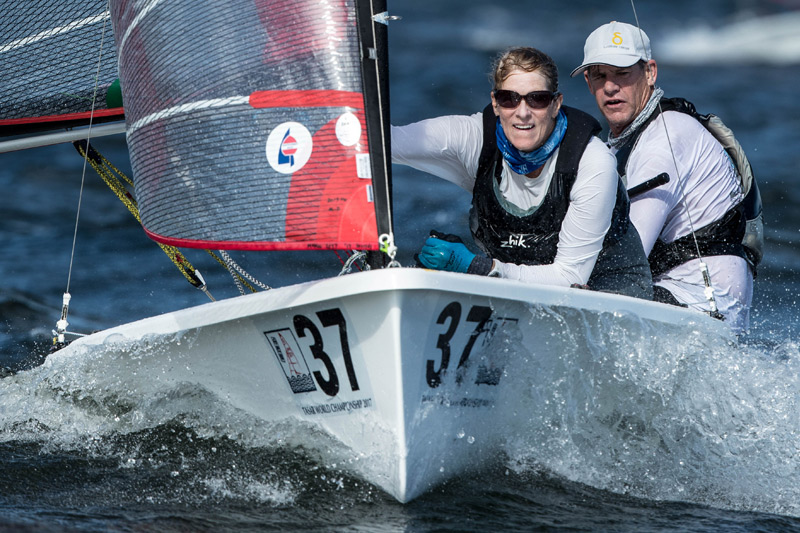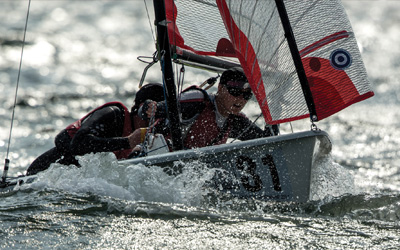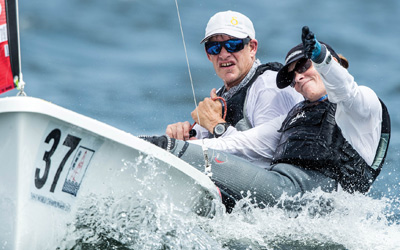
 Spending extended time on the water together as a couple can bring out both the best and worst in each other during the most ideal of circumstances. Throw in the high stress environment of competitive sailboat racing in the cold Pacific Northwest drizzle, and divorce lawyers might as well be waiting for new clients at the marina.
Spending extended time on the water together as a couple can bring out both the best and worst in each other during the most ideal of circumstances. Throw in the high stress environment of competitive sailboat racing in the cold Pacific Northwest drizzle, and divorce lawyers might as well be waiting for new clients at the marina.
However, every so often a boating couple emerges to show the rest of us how it’s done. Enter Seattle-based Jonathan and Libby McKee, an avid sailing power couple with an international record to show for it. Most recently, the McKees won the 2017 Tasar World Championship in Gamagori, Japan, held August 1 to 6. The competitive international fleet was a sizeable 97 boats.
The title of Tasar World Champions is familiar to the McKees. The duo won the Tasar Worlds in the 2007 race in Phuket, Thailand, 2003 at Esquimalt, Vancouver Island, Canada, and in the Columbia River Gorge in the 1990s. Libby and Jonathan may very well be the most decorated married couple of the Tasar world. But what factors have led to their success, both as a couple and a top-tier Pacific Northwest sailing team? Is their success a recipe that can be duplicated? For the sake of couples with boating aspirations everywhere, I reached out to the McKees. Jonathan just returned from the J/70 World Championships in Port Cervo, Italy, and Libby is on her lunch break from her job at Amazon. Libby has been keeping an eye on their two kids while Jonathan was abroad (a girl, age 13, and boy, age 16).
“Jonathan just got back from Europe yesterday and I was in all-day meetings last week and single-parenting at night,” says Libby, describing the hustle that many working parents can relate to, perhaps minus the international sailing factor. To the McKees, the success in Japan is still a fresh experience.
“When you’re at a championship like that, you’ve been working towards it with everything you’ve got for a while,” says Jonathan. “Everything you’re doing day and night is consumed with the goal of trying to win this race. It’s the opposite of a vacation. The first few races were very windy, which played to our strong suits.”
“I like that we’re 100% present, in the now with competitive sailing,” says Libby. “You get into this rhythm of the regatta and you have to stay present during thousand of micro-moments on and off the water. Jonathan was very precise with tactical calls. The difference between tacking here and 100 yards farther was the difference between fifth and twelfth place. It’s a lot easier to make a play to first from fifth place than twelfth. Jonathan did a wonderful job of seizing opportunities.”

Jonathan certainly has a record that would suggest as much. He launched into the professional sailing sphere in the 1984 Summer Olympics in Los Angeles, where he and Pacific Northwest sailing giant Carl Buchan won the gold medal in the Flying Dutchman class. The team remains the only Americans to ever win a gold medal for the Flying Dutchman class in the Olympics. Brothers Jonathan and Charles McKee had their big day in the 2000 Summer Olympics in Sydney, Australia, where they won a bronze medal in the 49er class. The two have gone on to sail for OneWorld in the 2003 Louis Vuitton Cup and for Luna Rossa Challenge in the 2007 Louis Vuitton Cup. Also notable, Jonathan sailed on Il Mostro in the 2008/2009 Volvo Ocean Race.
“Libby is a very accomplished sailor in her own right,” adds Jonathan. “She has won the Adams Cup three times (US Women’s Keelboat Champs), and has also sailed in the Women’s World Championship in Brazil, as well as numerous other exploits in dinghies and keelboats. She is currently racing an RS Aero. She is also in excellent physical condition, which was a major contributor to our success in Gamagori.” Only a few minutes into my conversation with them, and the first clue to their success was making itself clear. The two are quick to provide genuine positive feedback to each other, a dynamic the pair believes helps propel them to success.
“The roles need to be divided and executed perfectly. Most of the conversation is either strategic or just supportive. We can do it! Hike for another beat! We can get those guys! kind of stuff,” adds Libby.

“The micromanaging, operational things are unspoken and you have to trust each other to do our jobs. We do our best when we say very little to each other. Time spent explaining what to do is time wasted,” says Jonathan. Another critical element to their dynamic is that, on the course, they are sailing peers of equal footing. I’m-the-mansplaining-captain attitude has no place aboard.
“We aren’t hierarchical. Jonathan may have his hand on that tiller, but it takes two people fully engaged and present to win,” says Libby. The McKee approach is in many ways a guiding philosophy of the boat they sail, the Tasar, and the community that has grown around it in the Pacific Northwest.
“In my view, the most interesting story is the Tasar Class and its evolution in the Pacific Northwest,” says Jonathan. “Many of the best sailors in the Pacific Northwest have raced Tasars at one time, and local sailors have won the World Championships 11 times. I find that number quite astounding for such a competitive international class.”
“A big part of our success is thanks to the Tasar community in the Pacific Northwest that we train with,” adds Libby. Other notable Pacific Northwest Tasar racing couples include Carl and Carol Buchan and brother Charlie and Becky McKee (both teams/married couples who are also world champs). Additionally, three other Pacific Northwest teams competed alongside the McKees in Japan (Jay and Lisa Renehan [also married World Champions], Michael Karas and Molly Jackson, and Brian and Luke Johnson [father and son]). Jonathan and Libby recall fondly the many weekend regattas with the Tasar community.
“For Gamagori, the four Pacific Northwest teams decided to train together to maximize our learning and create a positive and fun atmosphere. We started training in March and sailed two or three days per week through July. We only raced a couple of days in all that time, but our practice was well coordinated. We shared our techniques, settings, and thoughts with each other openly,” says Jonathan. “This open atmosphere is quite unusual, as normally sailors try to keep what they know to themselves. But it makes for a more collaborative, fun, and interactive training, and is something that the local Tasar fleets have always embraced. There is no question that we all improved tremendously during this spring and summer, and we attribute our success at the Worlds largely to this. So the other local teams were a big part of our victory. Equally important, we really looked forward to each day of training. It was less like work and more like play.”

“The Northwest spirit of collaboration is great,” agrees Libby. “The community is a big part of how we were able to come into this event, a little old and off the racing scene, to win that convincingly in Japan.”
Beyond the Japan race, the Tasar community of the Pacific Northwest is what brought Libby and Jonathan together. The two began sailing together aboard a Tasar 29 years ago, two years before they officially tied the knot. Libby feels as if the Tasar is a natural fit for the Pacific Northwest attitude.
“Sailing Tasars is very different than sailing Stars or Melges 24s,” says Libby. “There’s this supportive, organic, no-pretense community here in the Pacific Northwest. There’s great nearby locations for Tasar racing like Shilshole Bay and the lakes around Seattle. The boats themselves are fundamentally simple, but they are also high performance. Races are dynamic and interesting.’
“The Tasar was specifically designed to be a boat for couples to sail,” adds Jonathan. “Thus there is no trapeze or spinnaker. However, it achieves high performance upwind and down through a combination of design factors: very lightweight, a wide-chined hull with flat aft sections, efficient foils, a rotating mast, and fully battened sail. So it’s not hard to sail, but still presents a lot of interesting challenges for top sailors. Libby and I sailed our first Tasar regatta in 1987 at the Tasar Nationals in Seattle. We were not married at that time.”
—Libby McKee
“There are not that many activities that a couple can do that are at a high level and with equal footing. When it’s just the two of you, it’s pretty intense. But racing as a couple does add something special to the experience. You’re not only doing well in the race, but also strengthening your relationship.”
—Jonathan McKee

“We knew each other from the sailing community. When Jonathan was doing 18-footers the first time, I was dating somebody else. But Jonathan and I got to know each other a bit better there. Some time later, we decided to sail a Tasar together,” recounts Libby.
“Really, Tasars are designed for one male and one female from a crew weight perspective. During our time with Tasars, a number of people early in their marriages or dating were active in the fleet. We couples would go around to beautiful lakes and parts of the Pacific Northwest and have rabbit starts or our own races. We called them ‘Bush Regattas.’ We’d camp out at night and drink red wine and go racing and trailer our boats home. What’s great is that they were away from the yacht club scene. It was more about the community and camaraderie,” says Libby. “That was the early part of our relationship. It was great.”
As I talk more with the McKees, I grow to view their success as more than the end-result of a carefully crafted recipe with ingredients such as individually intrinsic love of sailing, mutual support, a thirst for growth, and trust between the two. The external factors, such as the couple-friendly design of the Tasar itself and the collaborative community of Pacific Northwesterners around it, seem to serve as the all-important incubator oven. To the McKees, the journey to the world championship was overflowing with joyful days on the water with their dearest friends. Racing Tasars is a chance to put each other first in their bustling lifestyles where careers, kids, and the buzz buzz buzz of life too often gets in the way.
“We really got to turn into our relationship during this experience, and we race with some of the dearest people to us in our lives,” says Libby. “These people are the same who attended our wedding! We really enjoy doing it, so whenever there is an opportunity to get out on a Tasar, we’ll go for it.” As far as future championship regattas are concerned, nothing is set in stone but, “I guarantee you’ll see us out on the water, for it’s much more than a hobby to us. Coming to a race course near you,” says Libby proudly.
“Definitely!” agrees Jonathan. I have no doubts as I say my goodbyes.


